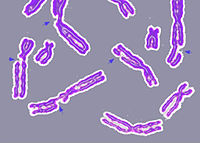
Photo from wikipedia
Fumarase is an enzyme of the tricarboxylic acid (TCA) cycle in mitochondria, but in recent years, it has emerged as a participant in the response to DNA double strand breaks… Click to show full abstract
Fumarase is an enzyme of the tricarboxylic acid (TCA) cycle in mitochondria, but in recent years, it has emerged as a participant in the response to DNA double strand breaks (DSBs) in the nucleus. In fact, this enzyme is dual-targeted and can be also readily detected in the mitochondrial and cytosolic/nuclear compartments of all the eukaryotic organisms examined. Intriguingly, this evolutionary conserved cytosolic population of fumarase, its enzymatic activity and the associated metabolite fumarate, are required for the cellular DNA damage response (DDR) to double-strand breaks. Here we review findings from yeast and human cells regarding how fumarase and fumarate may precisely participate in the DNA damage response. In yeast, cytosolic fumarase is involved in the homologous recombination (HR) repair pathway, through its function in the DSB resection process. One target of this regulation is the resection enzyme Sae2. In human cells, fumarase is involved in the non-homologous end joining (NHEJ) repair pathway. Fumarase is phosphorylated by the DNA-dependent protein kinase (DNA-PK) complex, which induces the recruitment of fumarase to the DSB and local generation of fumarate. Fumarate inhibits the lysine demethylase 2B (KDM2B), thereby facilitating the dimethylation of histone H3, which leads to the repair of the break by the NHEJ pathway. Finally, we discuss the question how fumarase may function as a tumor suppressor via its metabolite substrate fumarate. We offer a number of models which can explain an apparent contradiction regarding how fumarate absence/accumulation, as a function of subcellular location and stage can determine tumorigenesis. Fumarate, on the one hand, a positive regulator of genome stability (its absence supports genome instability and tumorigenesis) and, on the other hand, its accumulation drives angiogenesis and proliferation (thereby supporting tumor establishment).
Journal Title: Frontiers in Molecular Biosciences
Year Published: 2018
Link to full text (if available)
Share on Social Media: Sign Up to like & get
recommendations!